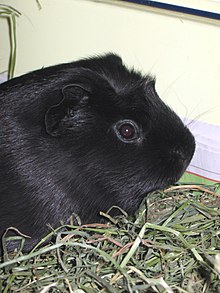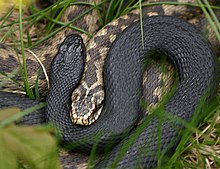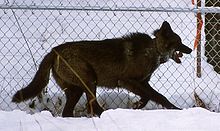Melanism



Melanism is a development of the dark-colored pigment melanin in the skin or its appendages and is the opposite of albinism. Historically, it was also the medical term for black jaundice.[2]
The word melanism is derived from the Greek: μελανός ("black pigment").[3]
Pseudo-melanism, also called abundism, is another variant of pigmentation, characterized by dark spots or enlarged stripes, which cover a large part of the body of the animal, making it appear melanistic.[4] A deficiency in or total absence of melanin pigments is called amelanism.
The morbid deposition of black matter, often of a malignant character causing pigmented tumors, is called melanosis.[5] For a description of melanin-related disorders, see melanin, melanosis coli and ocular melanosis.
Adaptation

Melanism related to the process of adaptation is called adaptive. Most commonly, dark individuals become fitter to survive and reproduce in their environment as they are better camouflaged. This makes some species less conspicuous to predators, while others, such as black panthers, use it as a foraging advantage during night hunting.[6] Typically, adaptive melanism is heritable: A dominant gene, which is entirely or nearly entirely expressed in the phenotype, is responsible for the excessive amount of melanin.
Adaptive melanism has been shown to occur in a variety of animals, including mammals such as squirrels, many felines and canids, and coral snakes. Adaptive melanism can lead to the creation of morphs, the most notable example being the peppered moth, whose alleged evolutionary history in the United Kingdom is mistakenly offered as a classic instructional tool for teaching the principles of natural selection.[7]
Industrial Melanism
Industrial melanism is an effect of urban pollution prominent in many species of arthropods. It is the phenomenon of an organism evolving dark pigmentation when exposed to an environment polluted by dark soot deposit and sulfuric buildup from industrial pollution. In this type of industrial melanism, the darker pigmented individuals develop a higher fitness and are favored by natural selection. This change in favoritism as a result of modification in selection pressure is one of the best-noted cases of Darwinian evolution.[8] The most common case of this adaptation is found in the arthropod order Lepidoptera. This order of insects encompasses all insects with microscopic scales on their wings, such as moths and butterflies. Some species thought to undergo the selection of industrial melanism are Adalia bipunctata (two-spot ladybird), Hamadryas feronia (variable cracker butterfly), Odontopera bidentata (scalloped hazel moth), Oligia latruncula (tawny marbled minor moth), Oligia strigilis (marbled minor moth), and many other species of moths; but probably the best and most studied example of industrial melanism is in the peppered moth, Biston betularia. Originally, peppered moths lived where light-colored lichens covered the trees where they would rest. To camouflage with the tree, they originated with a light-colored pigment that helped them to avoid predators by not being a visual distraction. Lichens are great bio-indicators of air-pollution.[9] Sulfur dioxide present in the atmosphere reduces the amount of lichen covering the surrounding trees. Eventually, industrial pollution came to the area, and sulfur dioxide began to kill the light-colored lichens off the trees, exposing the dark bark of the moths' resting places, creating a drastic contrast in color and making the light-colored moths more vulnerable to predation. This slowly altered the balance of the population, as light-colored moths were not surviving to reproduce and pass on their genes to the next generation, and the darker-colored moths began to breed more due to their new-found rise in fitness.[10] This reversal of survivability made the gene contributing to melanic forms of the moth more desirable. The melanic phenotype of the Biston betularia has been calculated to give a fitness advantage as great as 30 per cent.[11] As generations went on, eventually the population of peppered moths transformed from the majority being light-colored moths to the majority being dark-colored moths.
Melanic Biston betularia have also been widely observed in North America. In 1959, 90% of the Biston betularia in Michigan and Pennsylvania had the melanic phenotype.[12] By 2001, melanism dropped to 6% of the population, following clean air legislation.[12] The drop in melanism is also correlated with an increase in species richness of lichens, a decrease in atmospheric sulfur dioxide, and an increase in the pale phenotype[13] The return of lichen and reduction of atmospheric sulfur dioxide is directly correlated and helps illustrate how influential air-pollution levels are to the frequency of melanism for Biston betularia.
In each of these situations, the melanized form of the organism was found in an environment in correlation to higher amounts of industrial pollution found in the area. Many studies have been done to determine the reasons for the favoritism of darker pigmentation. Most studies aim to define the mechanism as a visual camouflage factor that gives the darker-pigmented individuals a higher fitness, but some studies try to find other ways that melanization can be an asset and, in turn, more favorable than the lighter-pigmented individuals. It is thoroughly noted that higher populations of darker-pigmented organisms develop when there is an increase in industrial pollution in the area, but the relationship can not be fully proven because the exact reason for increase in survivability can not be tracked and pin-pointed.[14] To further solidify the theory of industrial melanism as an actual selection factor within evolution, surveys of melanic population rates and changes in atmospheric condition have been reported to establish and confirm trends of favoritism of darker pigmented individuals in an industrially polluted area. As government regulations of air quality control have been implemented throughout the United States and the United Kingdom, researchers have collected data on melanic populations before and after the decontaminating effects of these regulations. According to their results, melanic population rates are consistent with the theory of industrial melanism, meaning that the level of melanic population was directly correlated to the abundance of contaminated air quality. When the levels of atmospheric pollution were high, so was the population rate of dark-colored moths, and when the levels of atmospheric pollution were low, there was a decline of melanism in the population.[14]
Industrial melanism is mostly concerned with the visual effects of melanization. The idea is that the darker pigmentation helps to camouflage the organisms better in an environment darkened by pollution and therefore heightens the fitness by making it less accessible to predators; but there are a few other ideas about why melanization can help improve fitness in air-polluted areas for these populations that are not correlated to any visual effect at all. It is theorized that organisms that experience melanization have better immunity to toxic chemicals put into the environment by industrial pollution. Other studies have been conceived to find other aspects of melanization contributing to the survivability of the organism other than visual inconspicuousness. In the black arches moth (Lymantria monacha), it has been determined that the darker pigmented forms have also developed a stronger immune response to foreign objects with the attribution of the melanic pigment. The same melanic pigment that contributes to the visual coloration of the moth is also involved in the encapsulation process of foreign invaders through the immune defense of the dark-colored form of the organism.[15] This enhanced defense against foreign invaders is helpful in an environment contaminated by industrial pollution because the toxins that are put out into the air have less chance of negatively affecting the inhabitants of that environment.
Another proposed mechanism for rapid industrial melanization is that there is a thermal advantage from the darker coloration. Many suspect that this thermal advantage coupled with the predation advantage, gives species such as the Biston betularia and Adalia bipunctata increased fitness.[16] The thermal advantage of industrial melanism is directly linked to the pollution aspect of industrialization.[16] Smoke and particulates in the air reduce the level of sunshine that reaches the habitats the Biston betularia and Adalia bipunctata. Melanic phenotypes become selectively advantageous in this situation because the dark coloration allows for a more efficient absorption of the limited sunlight.[9] In colder environments, the thermal advantages of industrial melanism increases activity and the likelihood to mate. In the Netherlands, melanic Adalia bipunctata had a distinct mating advantage over the non-melanic Adalia bipunctata[17] In the Adalia bipunctata, copulation is much more likely to occur with warmer body temperatures and increased activity.[17] Increased body temperature also gives melanic morphs a competitive advantage in searching for food because they are more active.[9] Industrial melanism allows species such as the Biston betularia and the Adalia bipunctata to more efficiently warm their bodies in environments of reduced sunshine, increasing their mating activity and nutrition, thus increasing their fitness.
In felines
Melanistic coat coloration occurs as a common polymorphism in 11 of 37 felid species and reaches high population frequency in some cases but never achieves complete fixation. The black panther, a melanic form of leopard, is common in the equatorial rainforest of Malaya and the tropical rainforest on the slopes of some African mountains, such as Mount Kenya. The serval also has melanic forms in certain areas of East Africa. In the jaguarundi, coloration varies from dark brown and gray to light reddish. Melanic forms of jaguar are common in certain parts of South America.[18] In 1938 and 1940, two melanistic bobcats were trapped alive in sub-tropical Florida.[19]
In 2003, the dominant mode of inheritance of melanism in jaguars was confirmed by performing phenotype-transmission analysis in a 116-individual captive pedigree. Melanistic animals were found to carry at least one copy of a mutant MC1R sequence allele, bearing a 15-base pair inframe deletion. Ten unrelated melanistic jaguars were either homozygous or heterozygous for this allele. A 24-base pair deletion causes the incompletely dominant allele for melanism in the jaguarundi. Sequencing of the agouti signalling peptide in the agouti gene coding region revealed a 2-base pair deletion in black domestic cats. These variants were absent in melanistic individuals of Geoffroy’s cat, oncilla, pampas cat and Asian golden cat, suggesting that melanism arose independently at least four times in the cat family.[20]
Melanism in leopards is inherited as a Mendelian, monogenic recessive trait relative to the spotted form. Pairings of black animals inter se have a significantly smaller litter size than other possible pairings.[21] Between January 1996 and March 2009, leopards were photographed at sixteen sites in the Malay Peninsula in a sampling effort of more than 1000 trap nights. Of 445 photographs of melanistic leopards taken, 410 came from study sites south of the Kra Isthmus, where the non-melanistic morph was never photographed. These data suggest the near fixation of the dark allele in the region. The expected time to fixation of this recessive allele due to genetic drift alone ranged from about 1,100 years to about 100,000 years.[22] Melanism in leopards has been hypothesized to be causally associated with a selective advantage for ambush.[23]
In birds
In April 2015, an extremely rare black flamingo was spotted on the Mediterranean island of Cyprus.[24]
Immune system

Melanin has several physiological roles in maintaining health, such as the synthesis of vitamin D. Melanin is the primary determinant of the degree of skin pigmentation and protects the body from harmful ultraviolet radiation. Synthesis of 1,25-dihydroxyvitamin D3 in the skin, however, is dependent on ultraviolet B light. Highly pigmented skin, to the level found in people of African origin, abrogates almost all ultraviolet-induced 1,25-(OH)2D3 synthesis. Numerous animal models and clinical studies have underlined the essential role of vitamin D as a modulator of the different processes of the immune system. Evidence indicates that serum concentrations of 1,25-(OH)2D3 and the prevalence of autoimmune diseases in a certain population are associated with the latitude at which that population resides.[25]
Genes for melanism in felines may provide resistance to viral infections. A viral epidemic may explain the prevalence of black leopards in Java and Malaysia and the relatively high incidence of black leopards and black servals in the Aberdares region of Africa. Previously, black-furred felines in the Aberdares had been considered a high-altitude adaptation, since black fur absorbs more heat.[26]
Studies reported in New Scientist magazine in 2003 also suggested that recessive-gene melanism is linked to disease resistance rather than altitude. Melanistic cats may have better resistance to disease than cats with "normal" color coats. This would explain why recessive melanism persists when melanistic individuals are disadvantaged because they are poorly camouflaged in open areas.
Socio-politics
The term melanism has been used on Usenet, internet forums and blogs to mean an African-American social movement holding that dark-skinned humans are the original people from which those of other skin colour originate. The term melanism has been used in this context as early as the mid-1990s[27] and was promoted by some Afrocentrists, such as Frances Cress Welsing.
See also
- Albinism
- Albino and white squirrels
- Amelanism
- Erythrism
- Heterochromia iridum
- Leucism
- Piebaldism
- Vitiligo
- Xanthochromism
References
- ^ Morales, E. (1995). The Guinea Pig : Healing, Food, and Ritual in the Andes. University of Arizona Press. ISBN 0-8165-1558-1.
- ^ Webster's Revised Unabridged Dictionary (1913) Melanism. C. & G. Merriam Co. Springfield, Massachusetts. Page 910
- ^ Liddell, H. G., Scott, R. (1940). μελα^νός. In: A Greek-English Lexicon, revised and augmented throughout by Sir Henry Stuart Jones, with the assistance of Roderick McKenzie. Clarendon Press, Oxford.
- ^ Osinga, N., Hart, P., van VoorstVaader, P. C. (2010). Albinistic common seals (Phoca vitulina) and melanistic grey seals (Halichoerus grypus) rehabilitated in the Netherlands. Animal Biology 60 (3): 273−281.
- ^ Webster's Revised Unabridged Dictionary (1913) Melanosis. C. & G. Merriam Co. Springfield, Massachusetts. Page 910
- ^ King, R.C., Stansfield, W.D., Mulligan, P.K. (2006). A Dictionary of Genetics, 7th ed., Oxford University Press
- ^ Begon, M., Townsend, C. R., Harper, J. L. (2006). Ecology: From individuals to ecosystems. 4th ed., Blackwell Publishing Malden, Oxford, Victoria.
- ^ Majerus, M. E. (2009). Industrial melanism in the peppered moth, Biston betularia: an excellent teaching example of Darwinian evolution in action. Evolution: Education and Outreach, 2(1), 63-74.
- ^ a b c Muggleton, J., Lonsdale, D., Benham, B. R., 1975. Melanism in Adalia-bipunctata L (ColCoccinellidae) and its relationship to atmospheric pollution. Journal of Applied Ecology 2:451-464.
- ^ McIntyre, N. E. (2000). Ecology of urban arthropods: a review and a call to action. Annals of the Entomological Society of America, 93(4), 825-835.
- ^ Cook, L. M., Saccheri, I. J., 2013. The peppered moth and industrial melanism: evolution of a natural selection case study. Journal of Heredity 110:207-12
- ^ a b Grant, B. S., Wiseman L. L., 2002. Recent history of melanism in american peppered moths. Journal of Heredity 93:86-90.
- ^ Brakefield, P. M., Liebert, T. G., 2000. Evolutionary dynamics of declining melanism in the peppered moth in the Netherlands. Proceedings of the Royal Society of London Biology 267:1953-1957.
- ^ a b Grant, B. S., Cook, A. D., Clarke, C. A., & Owen, D. F. (1998). Geographic and temporal variation in the incidence of melanism in peppered moth populations in America and Britain. Journal of Heredity, 89(5), 465-471.
- ^ Mikkola, K., & Rantala, M. J. (2010). Immune defence, a possible nonvisual selective factor behind the industrial melanism of moths (Lepidoptera). Biological Journal of the Linnean Society, 99(4), 831-838.
- ^ a b Mikkola, K., Albrecht, A., 1988. The melanism of Adalia-bipunctata around the Gulf of FInland as an industrial phenomenon (Coleoptera, Coccinellidae). Annales Zoologici Fennici 25:177-85.
- ^ a b De Jong, P. W., Verhoog, M. D., Brakefield, P. M., 1992. Sperm competition and melanic polymorphism in the 2-spot ladybird, Adalla bipunctata (Coleoptera, Coccinellidae). Journal of Heredity 70:172-178.
- ^ Searle, A. G. (1968) Comparative Genetics of Coat Colour in Mammals. Logos Press, London
- ^ Ulmer, F. A. (1941) Melanism in the Felidae, with special reference to the Genus Lynx. Journal of Mammalogy 22 (3): 285–288.
- ^ Eizirik, E., Yuhki, N., Johnson, W. E., Menotti-Raymond, M., Hannah, S. S., O'Brien, S. J. (2003). "Molecular Genetics and Evolution of Melanism in the Cat Family" (PDF). Current Biology. 13 (5): 448–453. doi:10.1016/S0960-9822(03)00128-3. PMID 12620197.
{{cite journal}}: CS1 maint: multiple names: authors list (link) - ^ Robinson, R. (1970). "Inheritance of black form of the leopard Panthera pardus". Genetica. 41: 190–197. doi:10.1007/BF00958904. PMID 5480762.
- ^ Kawanishi, K., Sunquist, M. E., Eizirik, E., Lynam, A. J., Ngoprasert, D., Wan Shahruddin, W. N., Rayan, D. M., Sharma, D. S. K., Steinmetz, R. (2010) Near fixation of melanism in leopards of the Malay Peninsula. Journal of Zoology, Volume 282 (3): 201–206.
- ^ Majerus, M. E. N. (1998) Melanism: evolution in action. Oxford University Press, New York
- ^ Krol, Charlotte (2015-04-09). "Rare black flamingo spotted in Cyprus". The Telegraph. Archived from the original on 2015-04-25. Retrieved 2015-05-16.
{{cite news}}: Unknown parameter|deadurl=ignored (|url-status=suggested) (help) - ^ Shoenfeld, N., Amital, H., Shoenfeld, Y. (2009). The effect of melanism and vitamin D synthesis on the incidence of autoimmune disease. Nature Reviews Rheumatology 5: 99−105.
- ^ Seidensticker, J., Lumpkin, S. (2006). Smithsonian Q & A: the ultimate question and answer book. Cats. Collins, New York
- ^ "Sundiata, AFROCENTRISM: THE ARGUMENT WE'RE REALLY HAVING". Retrieved 2007-06-23.
Bibliography
- David Attenborough (2002). The Life of Mammals (TV-Series and book). United Kingdom: BBC.
- Kettlewell, Bernard (1973). The Evolution of Melanism. Clarendon Press. ISBN 0-19-857370-7.
- Majerus, Michael (1998). Melanism: Evolution in Action. Oxford University Press. ISBN 0-19-854982-2.
- Melanism and disease resistance in insects
- Fryer, G. 2013. How should the history of industrial melanism in moths be interpreted? The Linnean. 29 (2): 15 - 22.
